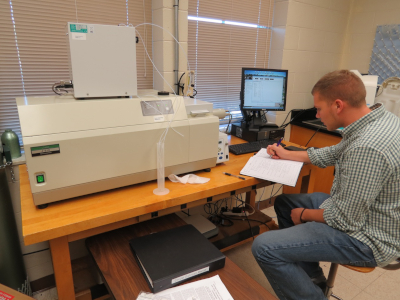Biophysics
 Active biophysics research spans across the expertise and interest of several faculty members in the physics department. As a result, students in our program have access to a wide range of research experiences, including ensemble studies of protein folding and stability, single molecule studies involving DNA, and optical trapping of bacteria. As elaborated below, each of these experiences allows students to gain hands-on experience on highly sophisticated and specialized professional-grade equipment as they seek answers to interdisciplinary real-world problems. And when they answer those questions (which they typically do), they are rewarded for their hard work by receiving an opportunity to present their results at a national or international conference.
Active biophysics research spans across the expertise and interest of several faculty members in the physics department. As a result, students in our program have access to a wide range of research experiences, including ensemble studies of protein folding and stability, single molecule studies involving DNA, and optical trapping of bacteria. As elaborated below, each of these experiences allows students to gain hands-on experience on highly sophisticated and specialized professional-grade equipment as they seek answers to interdisciplinary real-world problems. And when they answer those questions (which they typically do), they are rewarded for their hard work by receiving an opportunity to present their results at a national or international conference.
Protein folding and stability studies are performed with the department's Jasco J-810 spectropolarimeter coupled with a Peltier device, fluorescence monochrometer, and auto titrator. This system of instruments can optically monitor the changes in proteins as they are subjected to different thermal or chemical environments. Spectroscopic studies include circular dichroism, absorption, and fluorescence - ideas developed in physics that are now being used to obtain a picture of intricate protein structures.
Biological materials such as DNA have been imaged and manipulated using the department's Scanning Probe Microscope. Both contact and non-contact modes of atomic force microscopy (AFM) have been utilized in this area of research.
Optical tweezing of helical and magnetic bacteria has also been a successful research avenue for our students and faculty. The department has two optical trapping systems, a custom-built visible wavelength laser optical trap system and an infrared holographic optical trap (HOT Kit) system with epifluorescence capabilities. The HOT Kit (built by Arryx) uses a Nikon-Eclipse inverted microscope with a 3W infrared laser and has a three-dimensional micro translational stage. Students have successfully obtained over 200 individual optical traps and further studies utilizing this system are being explored.